Find aDomain Search Powered byGoDaddy.com ...
As this is the primary startup cost to getting going in this business, it is best to spend considerable time finding the right choices for the beginning of your vending machine empire.
We earn commissions if you shop through the links below. Read more
Written by: Carolyn Young
Carolyn Young has over 25 years of experience in business in various roles, including bank management, marketing management, and business education.
Edited by: Daniel Javor
Published on October 29, 2021
Updated on June 16, 2023
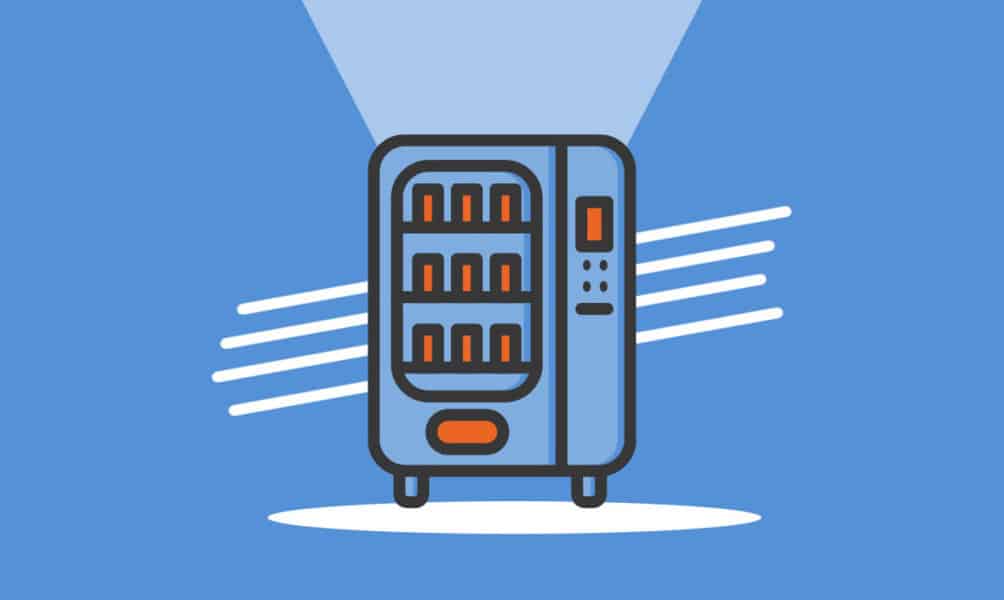
Investment range
$1,357 - $3,950
Revenue potential
$48,000 - $148,000 p.a.
Time to build
0 - 3 months
Profit potential
$10,000 - $30,000 p.a.
Industry trend
Growing
Commitment
Flexible
We see them everywhere, but have you ever considered what owning a business of vending machines would be like? Vending machines help people in a pinch, providing tasty treats and refreshing beverages at school, the office, and in public places of all kinds.
There are millions of vending machines out there in the world. Starting your own vending machine business is an opportunity to get in on the action. They can be a lucrative source of passive income and, depending on how many you are willing to operate, may not require a ton of upkeep for you as an entrepreneur.
But as with any business, getting started and making good money takes hard work. The best way to ensure success is moving patiently through the business development and launch process, as detailed in this step-by-step guide.

Every business has its advantages and disadvantages, which you should weigh to decide if starting a vending machine business is your best choice.
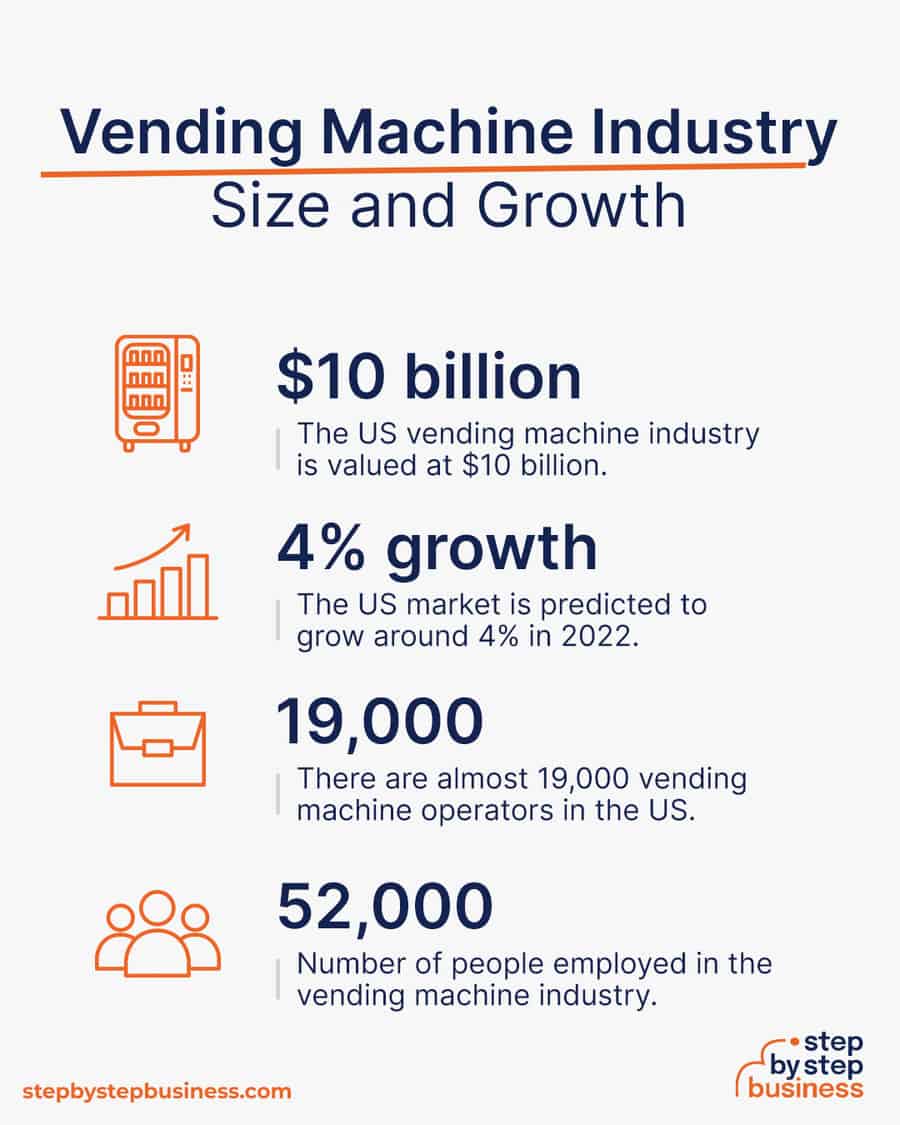
Key trends in the vending machine market include:
Challenges in the vending machine industry include:
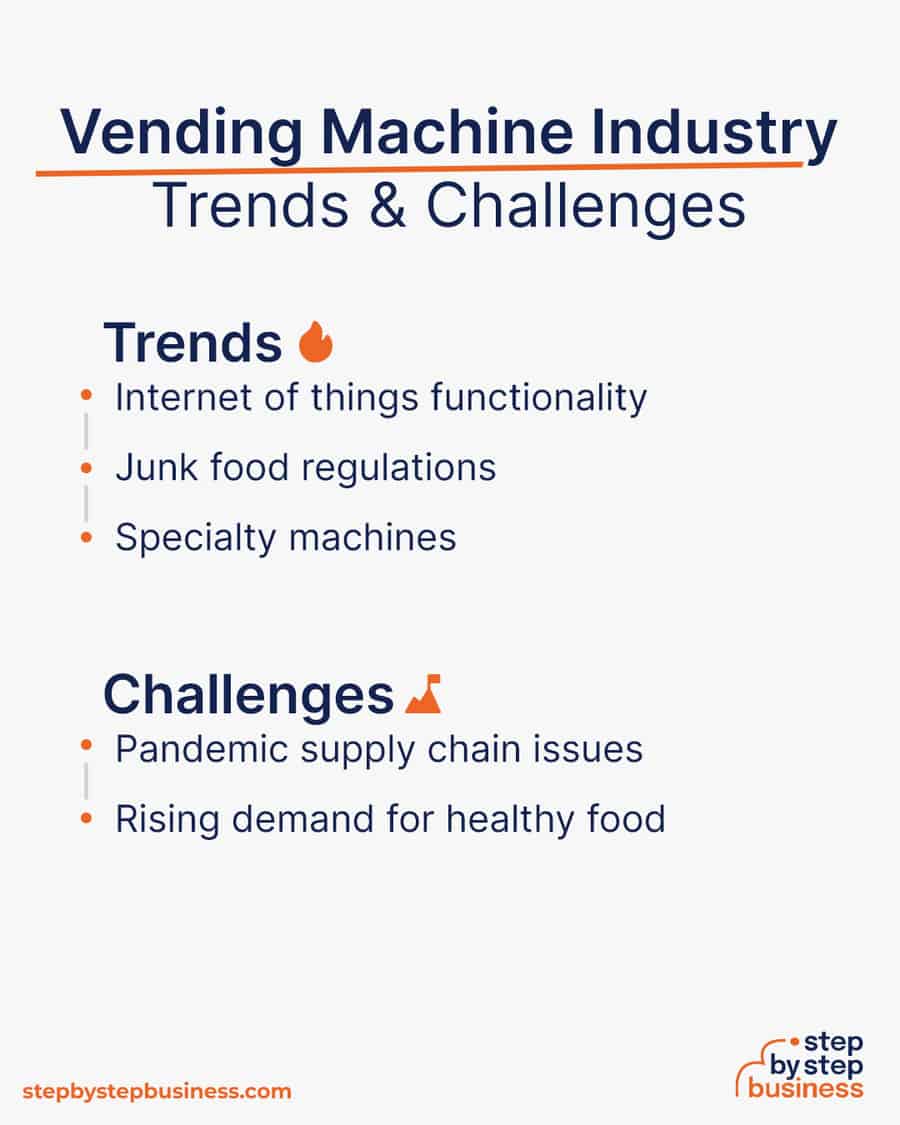
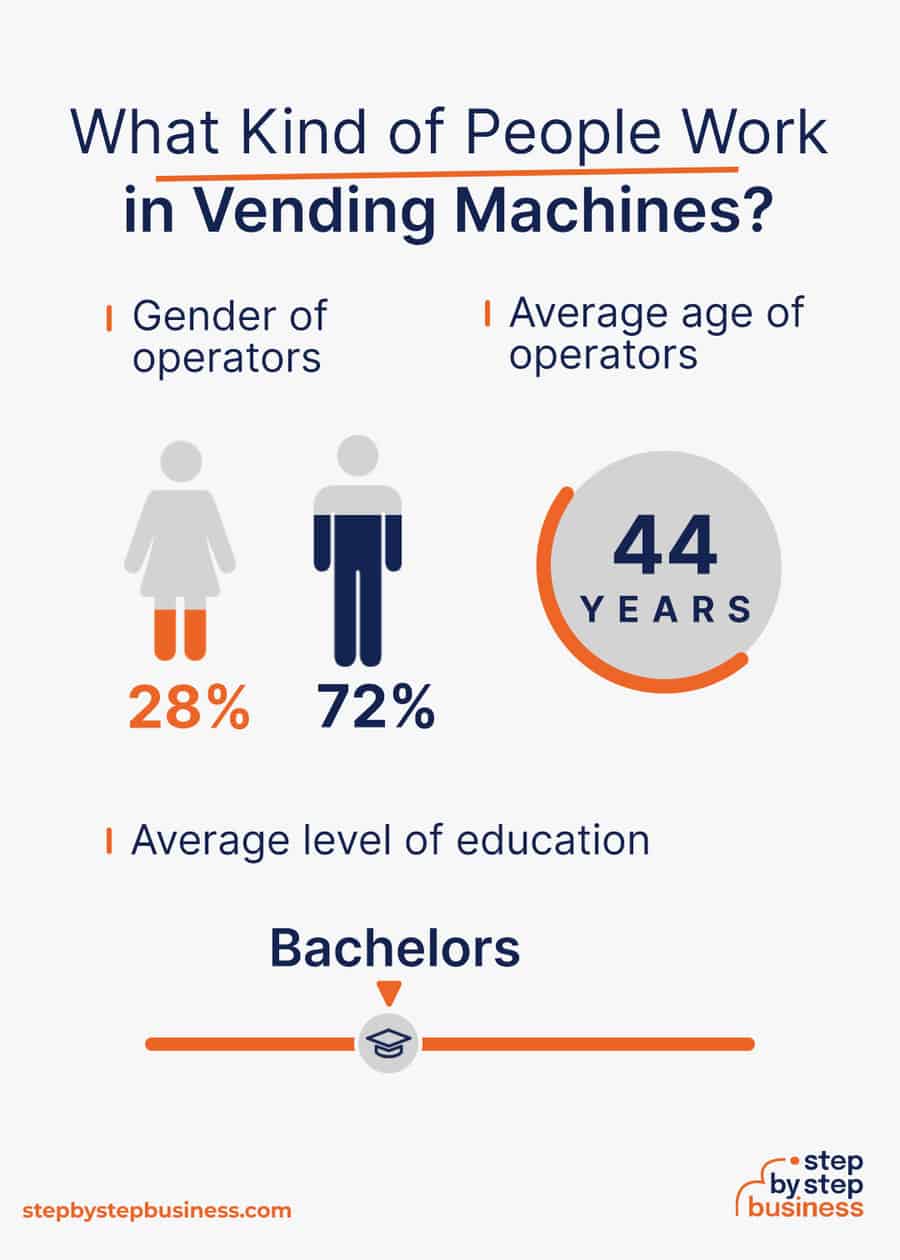
The startup costs for a vending machine business can range from around $1,400 to $4,000, according to Step By Step Research. The biggest expense is of course your vending machine or machines. The cost varies, depending on whether you purchase used or refurbished ones, or lease your machines on a monthly basis.
The other main startup costs include the required licenses and permits, as well as insurance, rent, and taxes. These costs vary widely based on your state and the business owners with whom you work.
You really only need one item to launch a vending machine business, but you might consider some additional equipment to help you get off the ground such as a truck and moving equipment. Keep in mind that additional costs will arise as you expand your business.
Here’s a sample computation, assuming you start with a refurbished vending machine. The cost would be much less if you just lease a machine, and higher if you get a new machine.
| Start-up Costs | Ballpark Range | Average |
|---|---|---|
| Vending machine | $1,000 - $3,000 | $2,000 |
| Licenses | $200 - $300 | $250 |
| Insurance | $100 - $500 | $300 |
| Inventory restock | $30 - $50 | $40 |
| Rent (% of sales to property) per machine | $15 - $80 | $48 |
| Taxes (% of sales based on state) per machine | $12 - $20 | $16 |
| Total | $1,357 - $3,950 | $2,654 |
For your vending machine business, profitability depends on location and scale. How many vending machines are you operating, and where they are located?
The average monthly revenue for a vending machine is $300 to $400, and with profit margins ranging from 16-25%, you’ll net about $50 to $100 from each machine every month. According to a survey by the entrepreneurial news site The Hustle, US vending machine operators oversee 13 machines on average and gross $309 per machine each month, bringing in $48,000 in annual revenue and $10,000 in profit (20.5% margin).
With a vending machine business, your annual revenue and profit will depend on the scale of your operation. The more machines, the more money you’ll make. To leverage economies of scale in key overhead costs — purchase/lease, installation, and maintenance — an entrepreneur would need to oversee at least 40 vending machines to generate $148,000 in annual revenue and make a livable salary of around $30,000.
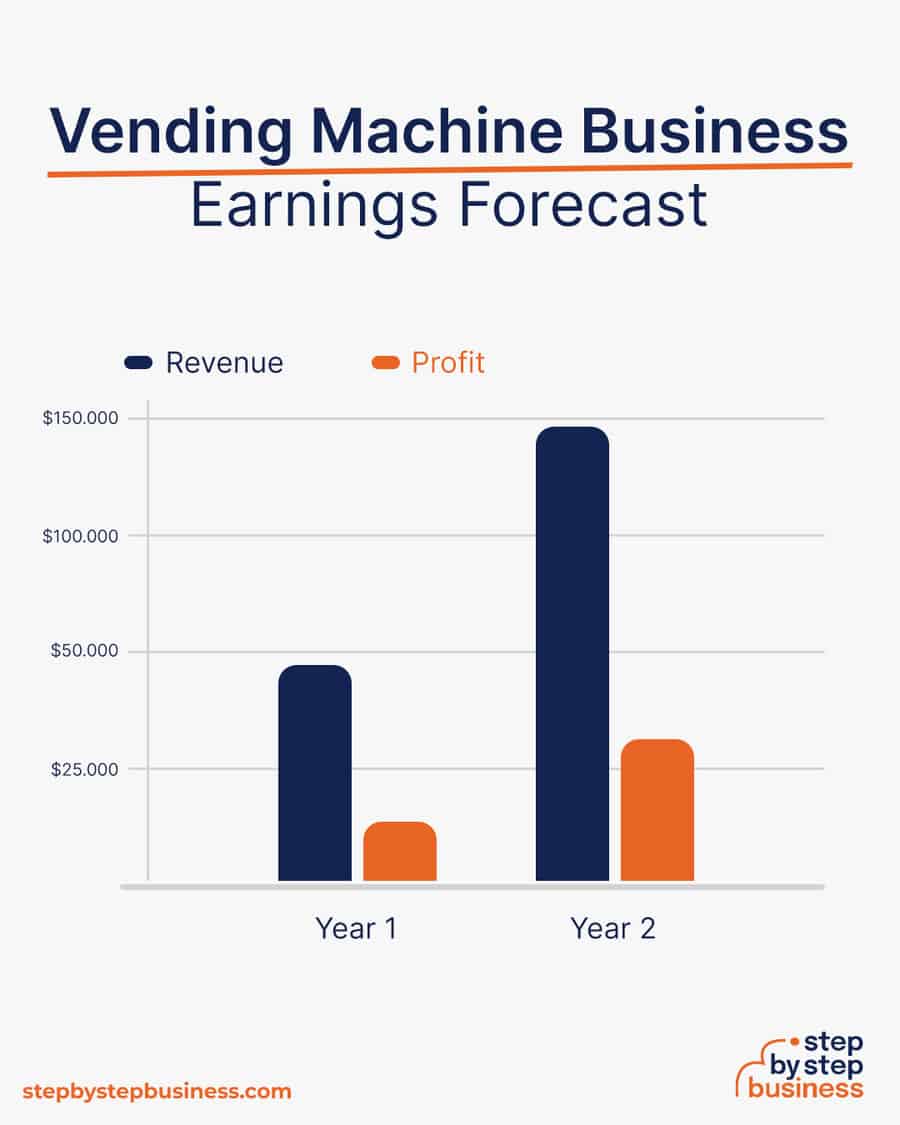

Now that you know what’s involved in starting a vending machine business, it’s a good idea to hone your concept in preparation to enter a competitive market.
Assuming you’re new to the vending machine industry, the first thing you should do is research. Find the most popular locations for machines in your city or town. Look into the types of vending machines – Drinks? Chips? Candy? – that are most profitable in your area and across the industry. Check nearby offices, hotels, hospitals, and other public spaces to see which items sell best — if it’s often out of stock, it must be in high demand!
Research the prices for local vending machines for sale, new or used, and check in on the leasing rates for machines available for lease.
As this is the primary startup cost to getting going in this business, it is best to spend considerable time finding the right choices for the beginning of your vending machine empire.
When it comes to product choice, the possibilities are broader than you might think.
Vending machines can offer food or drink, or both. They can feature tobacco products, which require a special license, or medical products, such as tests for pregnancy or COVID-19. Non-food vending machines sell items as wide-ranging as laundry detergent, iPhone accessories, and makeup. A new vending machine in Rome pumps out piping hot pizzas! Depending on the demand in your area, you might consider healthy vending machine options, which have gained popularity in recent years.
Payment options and food selection technology vary based on the machine. Some older models accept only cash and coin, while many newer vending machines only provide electronic payment and card options. The latest smart vending machines go even further, offering touchscreens as well as touch-free transactions via mobile payment.
Depending on your level of financing and personal preferences, it’s a good idea to examine all of your options.
The average food or drink item in a vending machine typically costs $0.50 to $2.00. But this will of course be higher if you decide to offer premium products. Either way, your prices should be competitive with machines offering similar products in your market.
A good approach is to initially offer all items in a specific category, such as candy bars or sodas, at the same price. From there, you see how sales go and experiment to find the right pricing for your location and product offerings.
Prices are of course based on the cost of the item, plus your target profit margin of around 20%.
Once you know your costs, you can use this Step By Step profit margin calculator to determine your mark-up and final price points. Remember, the prices you use at launch should be subject to change if warranted by the market.
The key market segments for vending machines include corporate offices, industrial workplaces, hotels, restaurants, schools, hospitals, and public spaces.
Manufacturing centers such as factories are often prime locations, mainly because blue-collar workers buy twice as many vending machine products as other groups.
You will want to position your vending machines in locations with a lot of foot traffic, preferably by people who are regularly gripped by pangs of hunger or thirst!
One of the best things about running a vending machine business is that you can operate out of your home. Your main job will be scouting out locations and then maintaining, restocking, and retrieving your money from the machines over time. Depending on the size of your operation, you may even be able to use your personal vehicle for these tasks.
As your business grows and operations intensify, you may need to hire workers for various job roles. You may also need to lease or buy a truck to better service your machines. If you do end up needing an office, you can find commercial space to rent in your area on sites such as Craigslist, Crexi, and Instant Offices.
When choosing an office space, you may want to follow these four rules of thumb:
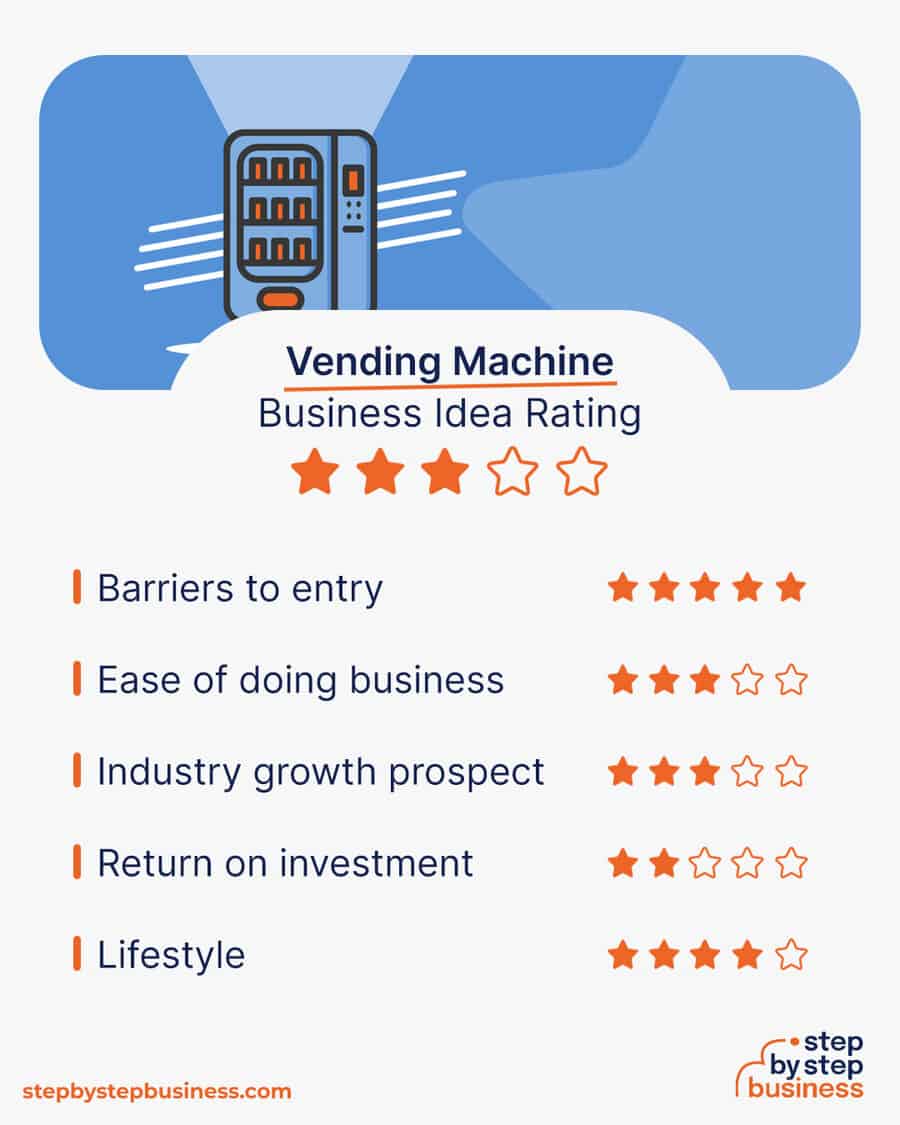

Your business name is your business identity, so choose one that encapsulates your objectives, services, and mission in just a few words. You probably want a name that’s short and easy to remember, since much of your business, and your initial business in particular, will come from word-of-mouth referrals.
Here are some ideas for brainstorming your business name:
Once you’ve got a list of potential names, visit the website of the US Patent and Trademark Office to make sure they are available for registration and check the availability of related domain names using our Domain Name Search tool. Using “.com” or “.org” sharply increases credibility, so it’s best to focus on these.
Finally, make your choice among the names that pass this screening and go ahead with domain registration and social media account creation. Your business name is one of the key differentiators that set your business apart. Once you pick your company name, and start with the branding, it is hard to change the business name. Therefore, it’s important to carefully consider your choice before you start a business entity.
Every business needs a plan. This will function as a guidebook to take your startup through the launch process and maintain focus on your key goals. A business plan also enables potential partners and investors to better understand your company and its vision:
If you’ve never created a business plan, it can be an intimidating task. You might consider hiring a business plan specialist at Fiverr to create a top-notch business plan for you.

Registering your business is an absolutely crucial step — a prerequisite to paying taxes, raising capital, opening a business bank account, and other guideposts on the road to getting a business up and running.
Registration is exciting because it makes the entire process official! Once it’s done, you have your own business.
Your business location is important because it can affect taxes, legal requirements, and revenue. Most people will register their business in the state where they live, but if you are planning to expand, you might consider looking elsewhere, as some states could offer real advantages when it comes to vending machine operations.
If you’re willing to move, you could really maximize your business! Keep in mind, it’s relatively easy to transfer your business to another state.
Businesses come in several varieties, each with its pros and cons. The legal structure you choose for your vending machine business shapes your taxes, personal liability, and business registration requirements, so it’s important to choose wisely.
Here are the main options:
We recommend that new business owners choose LLC as it offers liability protection and pass-through taxation while being simpler to form than a corporation. You can form an LLC in as little as five minutes using ZenBusiness’s online LLC formation service. They will check that your business name is available before filing, submit your articles of organization, and answer any questions you might have.

The final step before you’re able to pay taxes is getting an Employer Identification Number, or EIN. You can file for your EIN online or by mail or fax: visit the IRS website to learn more. Keep in mind, if you’ve chosen to be a sole proprietorship you can simply use your social security number as your EIN.
Once you have your EIN, you’ll need to choose your tax year. Financially speaking, your business will operate in a calendar year (January–December) or a fiscal year, a 12-month period that can start in any month. This will determine your tax cycle, while your business structure will determine which taxes you’ll pay.
The IRS website also offers a tax-payers checklist, and taxes can be filed online.
It is important to consult an accountant or other professional to help you with your taxes to ensure you are completing them correctly.
Securing financing is your next step and there are plenty of ways to raise capital:
Bank and SBA loans are probably the best options, other than friends and family, for funding a vending machine business.


Starting a vending machine business requires obtaining a number of licenses and permits from local, state, and federal governments.
Federal regulations, licenses, and permits associated with starting a vending machine business may include doing business as (DBA), health license and permit from the Occupational Safety and Health Administration (OSHA), trademarks, copyrights, patents, and other intellectual properties, as well as industry-specific licenses and permits.
Any vending machine that takes money in exchange for products requires its operator to get a state-based business license. You may also need a business license and local county or city-based health and food-handling licenses and permits. Additional beverage or food licenses may be required based on what your vending machines carry. If you plan to offer tobacco products or alcohol, you will need additional licenses. Additionally, your vending machines may need to be inspected to complete the application process, according to business launch adviser Corpnet.
You may also need state-level and local county or city-based licenses and permits. The license requirements and how to obtain them vary, so check the websites of your state, city, and county governments or contact the appropriate person to learn more.
You could also check this SBA guide for your state’s requirements, but we recommend using MyCorporation’s Business License Compliance Package. They will research the exact forms you need for your business and state and provide them to ensure you’re fully compliant.
This is not a step to be taken lightly, as failing to comply with legal requirements can result in hefty penalties.
If you feel overwhelmed by this step or don’t know how to begin, it might be a good idea to hire a professional to help you check all the legal boxes.
Before you start making money, you’ll need a place to keep it, and that requires opening a bank account.
Keeping your business finances separate from your personal account makes it easy to file taxes and track your company’s income, so it’s worth doing even if you’re running your vending machine business as a sole proprietorship. Opening a business bank account is quite simple, and similar to opening a personal one. Most major banks offer accounts tailored for businesses — just inquire at your preferred bank to learn about their rates and features.
Banks vary in terms of offerings, so it’s a good idea to examine your options and select the best plan for you. Once you choose your bank, bring in your EIN (or Social Security Number if you decide on a sole proprietorship), articles of incorporation, and other legal documents and open your new account.
Business insurance is an area that often gets overlooked yet it can be vital to your success as an entrepreneur. Insurance protects you from unexpected events that can have a devastating impact on your business.
Here are some of the different types of insurance to consider:


As opening day nears, prepare for launch by reviewing and improving some key elements of your business.
Being an entrepreneur often means wearing many hats, from marketing to sales to accounting, which can be overwhelming. Fortunately, a number of excellent software programs and digital tools can help you with many business tasks.
You may want to use a vending managing system to help manage your vending machines, with prices ranging from about $20 per month to $100 per month. But depending on the level of technology in your chosen machines, they may come pre-programmed with software that tracks inventory and revenue.
Some popular VMS websites are:
Much of your business will be walk-by customers, but you should still invest in digital marketing! Getting the word out is especially important for new businesses, as it’ll boost customer and brand awareness.
Once your website is up and running, link it to your social media accounts and vice versa. Social media is a great tool for promoting your business because you can create engaging posts that advertise your products:
Take advantage of your website, social media presence, and real-life activities to increase awareness of your offerings and build your brand. Some suggestions include:
Website development is crucial because your site is your online presence and needs to convince prospective clients of your expertise and professionalism. They are unlikely to find your website, however, unless you follow Search Engine Optimization (SEO) practices. These are steps that help pages rank higher in the results of top search engines like Google.
You can create your own website using services like WordPress, Wix, or Squarespace. This route is very affordable, but figuring out how to build a website can be time-consuming. If you lack tech-savvy, you can hire a web designer or developer to create a custom website for your business.
Unique selling propositions, or USPs, are the characteristics of a product or service that sets it apart from the competition. Customers today are inundated with buying options, so you’ll have a real advantage if they are able to quickly grasp how your vending machine meets their needs or wishes. It’s wise to do all you can to ensure your USPs stand out on your website and in your marketing and promotional materials, stimulating buyer desire.
Global pizza chain Domino’s is renowned for its USP: “Hot pizza in 30 minutes or less, guaranteed.” Signature USPs for your vending machine business could be:

You may not like to network or use personal connections for business gain. But your personal and professional networks likely offer considerable untapped business potential. Maybe that Facebook friend you met in college is now running a vending machine business, or a LinkedIn contact of yours is connected to dozens of potential clients. Maybe your cousin or neighbor has been working as a vending machine operator for years and can offer invaluable insight and industry connections.
The possibilities are endless, so it’s a good idea to review your personal and professional networks and reach out to those with possible links to or interest in vending machines. You’ll probably generate new customers or find companies with which you could establish a partnership. Online businesses might also consider affiliate marketing as a way to build relationships with potential partners and boost business.

You may not need to hire any employees if you are starting as a small business run out of your home. But as your business grows, you will likely need full-time employees to fill various job roles, such as:
At some point, you may need to hire all of these positions or simply a few, depending on the size and needs of your business. You might also hire multiple workers for a single role or a single worker for multiple roles, again depending on need.
Free-of-charge methods to recruit employees include posting ads on popular platforms such as LinkedIn, Facebook, or Jobs.com. You might also consider a premium recruitment option, such as advertising on Indeed, Glassdoor, or ZipRecruiter. Further, if you have the resources, you could consider hiring a recruitment agency to help you find talent.

You’re now ready to take the first step in your entrepreneurial journey. This may be one of the best passive income ideas, assuming what you have are brand new vending machines that don’t require much repair and maintenance services.
It’s not without risks, though. For example, not a few movies show a character kicking a vending machine when it fails to dispense or simply for free food or beverage. Well, the good news is that the latest technologies prevent misvends and other mishaps while improving customer experience.
So what are you waiting for? Get out there, deploy your machines, and start vending!
Vending machines can be quite profitable. Any given machine’s profitability will depend upon its location and overall pricing. Different food, drink, and product options have their own margins based, and a savvy owner will leverage the best ones. A well-placed and well-serviced vending machine can earn up to $400 in monthly revenue and $100 in profit.
Yes, vending machine owners generally pay 5-20% of sales revenue to the owners of the building or business where their machines have been installed.
Yes, vending machines are charged sales tax on the revenue they generate, which varies based on state.
The vast majority of vending machines are in commercial spaces such as offices, hotels, factories, entertainment spaces, and so on. You will likely need to sign a contract with the owner before installing your machines. For public places, you will need to reach out to the local government to find out what you need to do.

Published on August 16, 2023
Find aDomain Search Powered byGoDaddy.com ...
Read Now

Published on March 16, 2023
Lorem ipsum dolor sit amet, consectetur adipiscing elit, sed do eiusmod tempor incididunt ut labore et dolore magna aliqua. Ut enim ad minim veniam, ...
Read Now

Published on March 10, 2023
When to Use Paychex Flex When to Use QuickBooks Payroll ...
Read Now
No thanks, I don't want to stay up to date on industry trends and news.
Comments